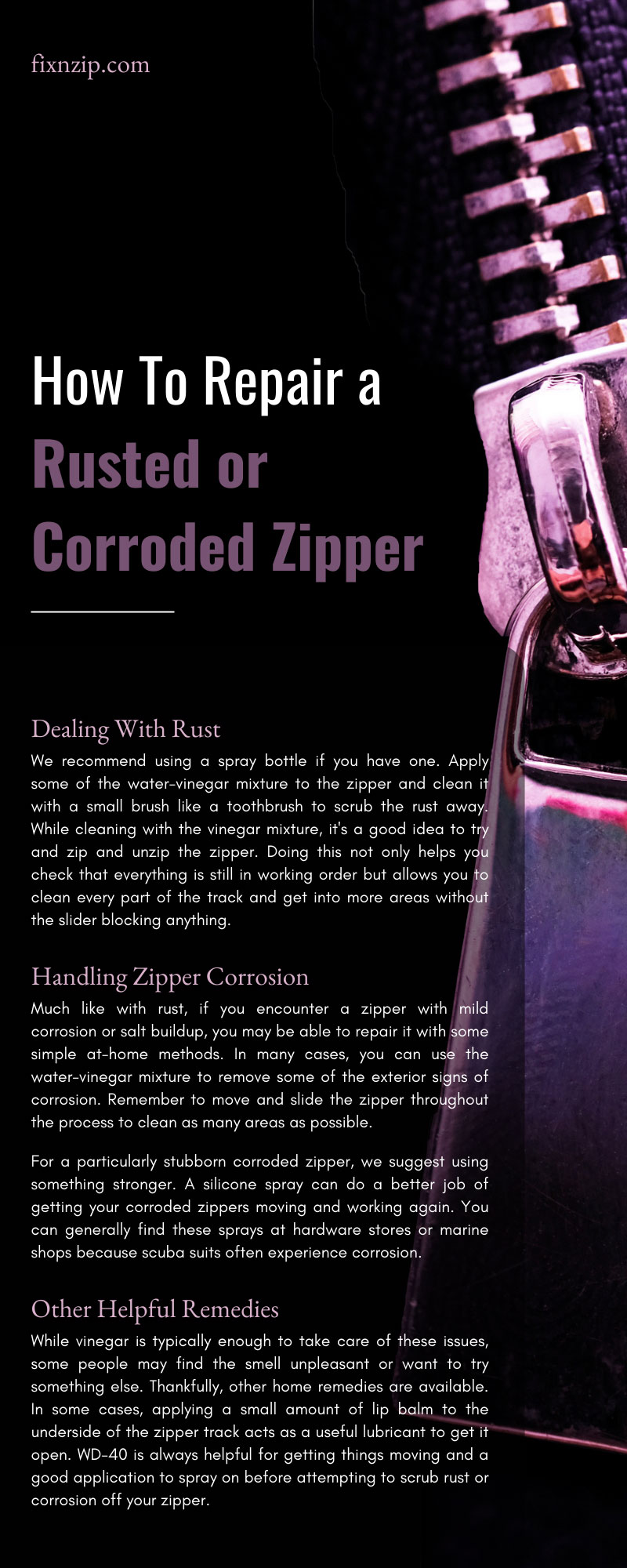
Do you ever grab an old jacket, suitcase, or sleeping bag from the closet and notice those telltale orange signs of rust and deterioration? Unfortunately, when we store items for extended periods of time and forget about them, various factors can lead to the metal zipper winding up in a rough shape.
Various facts can result in rust and deterioration, like humidity in the air or just a general lack of maintenance. Thankfully, you may not need to abandon the entire item if you know how to repair a rusted or corroded zipper. Before you consider spending money on a costly replacement, let’s see if we can recover the zipper and get things back on the right track.
Rust is something that metallurgists have debated about for a while now, and many different metals can create it. Essentially, rust forms when certain metals, usually iron, react to lengthy exposure to oxygen and water. Since oxygen and humidity exist all around us, it’s easy for the exterior of the metal to turn into these red, flaky oxides that cause damage to the metal and may eventually lead to corrosion.
However, most zippers, even metal ones, are not made from iron. When rust forms, it's generally not as damaging as it might be on other metals. This is beneficial because it means it's more likely or possible to work around the oxidation and still maintain a clean-looking, functional zipper.
If you notice small amounts of rust on the track or slider and have trouble opening and closing the zipper, there are a few home solutions you may want to consider—a simple mixture of white vinegar with hot water. The acids in the vinegar will help dissolve any rust build-up, while the water dilutes it enough to prevent any additional harm to the rest of the zipper.
We recommend using a spray bottle if you have one. Apply some of the water-vinegar mixture to the zipper and clean it with a small brush like a toothbrush to scrub the rust away. While cleaning with the vinegar mixture, it's a good idea to try and zip and unzip the zipper. Doing this not only helps you check that everything is still in working order but allows you to clean every part of the track and get into more areas without the slider blocking anything.
While rust is generally metal flakes that build up on the item through oxidation, corrosion takes many forms. Many of these forms involve deteriorating metal. Another common side effect of corrosion is a buildup of salt crystals that occur if you store the zipper for lengthy periods after exposure to salt air. You may commonly find these crystals on beach bags, tents, or other zippers that may have met salt water or nearby areas.
Much like with rust, if you encounter a zipper with mild corrosion or salt buildup, you may be able to repair it with some simple at-home methods. In many cases, you can use the water-vinegar mixture to remove some of the exterior signs of corrosion. Remember to move and slide the zipper throughout the process to clean as many areas as possible.
For a particularly stubborn corroded zipper, we suggest using something stronger. A silicone spray can do a better job of getting your corroded zippers moving and working again. You can generally find these sprays at hardware stores or marine shops because scuba suits often experience corrosion.
You may be wondering how to repair a rusted or corroded zipper. Silicone spray is a helpful maintenance tool to prevent these problems from occurring in the first place. It's not always easy to take preventative measures when you have something in storage, but it's a helpful tool to have around, just in case.
While vinegar is typically enough to take care of these issues, some people may find the smell unpleasant or want to try something else. Thankfully, other home remedies are available. In some cases, applying a small amount of lip balm to the underside of the zipper track acts as a useful lubricant to get it open. WD-40 is always helpful for getting things moving and a good application to spray on before attempting to scrub rust or corrosion off your zipper.
If you're lucky, any rust or corrosion you encounter isn't that bad. You can use a brush and some cleaner to take care of it and have everything in working order again. However, there are times when a little brush isn't going to do the trick, and you need to replace the zipper.
Replacements are generally only necessary if you notice some irreparable damage to the zipper, like several missing teeth. Rust and corrosion can be stubborn and may require multiple cleaning attempts.
If you do notice extensive damage on the slider, but the track of the zipper seems intact, you may just need to replace the slider. Slider replacement kits are inexpensive and easy to install with a pair of pliers. You can check the base of your zipper to see what size kit you need to buy and use pliers to remove the top stop of your zipper.
If the slider is subject to heavy rusting or corrosion, removing it may be a more difficult task, but one that should work with some gentle adjustments and WD-40. You want to take extra care not to damage the track while trying to remove the slider.
After you remove the slider, this may be a good opportunity to perform any additional cleaning of the teeth with no obstacles. If you decide to clean it, we recommend taking a soft cloth and ensuring that everything is dry before you attach the new slider. Attach it and check that it moves effortlessly before using your pliers to attach the new top stop.
Rust and corrosion are never fun, but when encountered in smaller doses, it’s a fairly manageable concern. For more information on zipper repair, FixNZip has a variety of helpful articles, replacement kits, and staff that are ready to aid you with any fastener-related problems. Contact us today with any questions, comments, or concerns.

